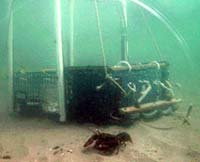Crustacean brawls caught on camera

Going to pot: scientists are re-assessing their lobster traps <br>© Winsor H. Watson, III <br>
Underwater video reveals lobsters behaving badly.
A lobster-pot is more like a Wild West saloon than a cunningly laid snare. Lobsters show up for food and a fight, and only the unlucky few get reeled in, underwater video footage is revealing.
Camera recordings show that lobster traps catch a mere 6% of the animals that enter them. The result suggests that lobsters’ rowdy behaviour could be confusing attempts to count and size them, and so to manage the fishery1.
“Predicting the future of the population is difficult,” says Stanley Cobb, who studies lobsters at the University of Rhode Island in Kingston. “Traps may not be sampling all parts of the population.” Egg-bearing females, for example, seem to avoid them, says Cobb.
Lobster numbers are usually estimated from the catches of experimental traps. To gauge
“A lot of lobstermen feel that traps are really feeding stations,” says Cobb. New England’s lobster fishery is in good health – perhaps, says Cobb, because of all the bait that fishermen put out. Lobster catches worth about $200 million are landed each year in Maine alone.
But researchers are not sure how long the good times can go on. “We catch about 90% of lobsters bigger than the legal size limit. I’m concerned we’re fishing too heavily,” says Watson. Catches are beginning to decline in the southern area of the fishery, and there are signs that disease is damaging the crustaceans.
Researchers would like to be able to read any warning signs, so that they can move to avert possible crashes, rather than have to repair a shattered fishery. To do this, they may need new ways of counting lobsters – one possibility Watson suggests is a trap that can catch multiple lobsters by moving them away from the entrance, “like a maze”.
References
- Jury, S. H., Howell, H., O’Gradt, D. F. & Watson, W. H. III Lobster trap video: in situ surveillance of the behaviour of Homarus americanus in and around traps. Marine and Freshwater Research, 52, 1125 – 1132 , (2001).
Media Contact
All latest news from the category: Life Sciences and Chemistry
Articles and reports from the Life Sciences and chemistry area deal with applied and basic research into modern biology, chemistry and human medicine.
Valuable information can be found on a range of life sciences fields including bacteriology, biochemistry, bionics, bioinformatics, biophysics, biotechnology, genetics, geobotany, human biology, marine biology, microbiology, molecular biology, cellular biology, zoology, bioinorganic chemistry, microchemistry and environmental chemistry.
Newest articles

Properties of new materials for microchips
… can now be measured well. Reseachers of Delft University of Technology demonstrated measuring performance properties of ultrathin silicon membranes. Making ever smaller and more powerful chips requires new ultrathin…

Floating solar’s potential
… to support sustainable development by addressing climate, water, and energy goals holistically. A new study published this week in Nature Energy raises the potential for floating solar photovoltaics (FPV)…

Skyrmions move at record speeds
… a step towards the computing of the future. An international research team led by scientists from the CNRS1 has discovered that the magnetic nanobubbles2 known as skyrmions can be…





















